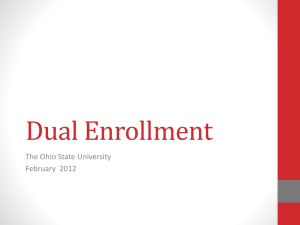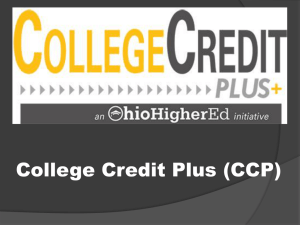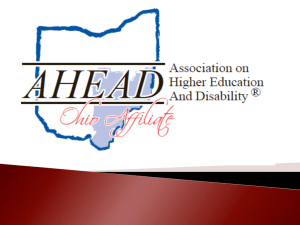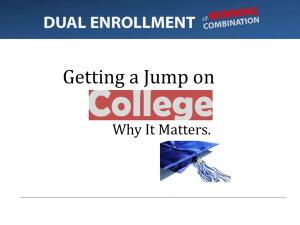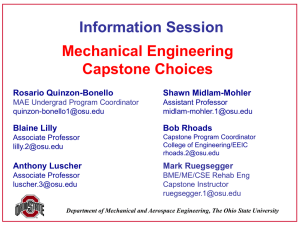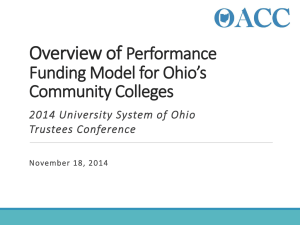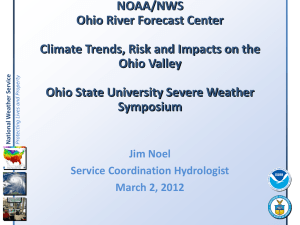Dual Enrollment - The Ohio State University
advertisement
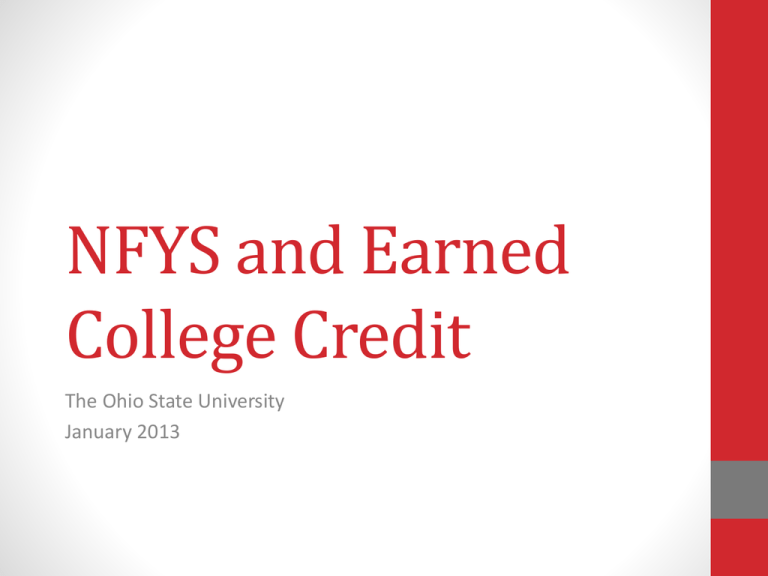
NFYS and Earned College Credit The Ohio State University January 2013 Original Charge from CAA 2009 • Scan for demand (with state, community, campus) • National, state, local perspectives • Yearly reports on the volume and quality of all accelerated learning/dual enrollment projects at Ohio State. • Ohio State offerings • Data trends • Organize and facilitate processes for partnerships/Develop new structures, standards, and best practices as needed. • Serving students Perspectives Nation State of Ohio Ohio State NFYS Students National Context • National and statewide goals are to provide all prepared students with opportunities • To earn college credit while in high school • To develop confidence in their abilities to be successful in college • To gain paths to lower costs of college educations for families. • Early Texas longitudinal study suggests that students who took dual enrollment courses were • 2.2 times more likely to enroll in college • 1.7 times more likely to complete a degree. National Context Common Core Standards in math and English College access and completion goals MOOCs and other online courses NFYS with deeper and narrower preparation, more use of technology State of Ohio Context Community colleges ramping up: Central Ohio Compact OBOR goals of increasing credit opportunities: dual enrollment, online, etc. K-12 districts’ goals of providing more dual enrollment NFYS with more college credit. May take fewer GE courses State of Ohio Dual Enrollment • Courses: Most dual enrollment courses are general education or TAG courses. • Teacher credentials: High school instructors required to have Master’s degree or 18 hours+ in the content field. OBR convened statewide faculty credentials committee. • Ohio Board of Regents upcoming release of RFP to offer Master’s Degrees in the content to high school teachers. • Funding model not yet approved. Ohio State Online options: MOOCs, ilearnohio.org Dual Enrollment/Early College AP, IB, CLEP Policies NFYS with more college credit. May take fewer GE courses Career Technical Assurance Guidelines Ohio State Yearly Report • Ohio State Dual Enrollment/Early College • Niche Partnerships • Ohio State Academy • Metro Early College High School • Data Trends Ohio State Dual Enrollment 2009 CAA approved faculty-developed proposal http://ugeducation.osu.edu/dual-enrollment.shtml 400 350 300 250 200 150 100 50 0 2011-2012 2010-2011 Ohio State Academy • Individual, highly qualified students are admitted under standards comparable to NFYS standards. • 2011-2012 • • • • • 336 students attended OSU Academy on all campuses. 203 students attended Columbus OSU Academy 197 were seniors 149 applied to OSU Columbus and were admitted 74 are attending 2012-2013 • http://undergrad.osu.edu/academy/ Metro Early College STEM High School • Early College Learning Centers • Year-long interdisciplinary, project-based integrations of high school and college coursework • First steps to early college work • Partner with other high school district • Metro Student Admissions • Demonstrated preparedness in mastery (90%) coursework • No Works in Progress • Recommendations from teachers and principal about college readiness skills beyond course content (development resilience, etc.) • Any appropriate placement tests Metro Early College Learning Centers • Bodies (2009-present) • • • • • High school Project Lead the Way biomedical course Biology 1113, 1114 and global health Ohio State University Wexner Medical Center rotations Field studies in China, Costa Rica, Virgin Islands Reynoldsburg/CSCC • Design (2011-present) • • • • High school Project Lead the Way robotics course Engineering 1187, 1221, Math 1151 FIRST Robotics Competition Dublin/OSU Academy Metro Early College Learning Centers • Energy, Environment, and Economics (2011-present) • • • • High school global studies/social studies ENR 2100, SES 1121 Energy Summit Reynoldsburg/CSCC • Growth (2010-2011 and in planning for 2013): • • • • High school botany, technical writing HCS 2201, 2201 Farmer’s market Linden McKinley STEM Academy/niche OSU Ohio State Metro Grads College Credit by Graduation Class 100 90 80 70 60 At Graduation 50 After 1 Year After 2 Years 40 30 20 10 0 2010 2011 2012 Ohio State Metro Grads By Credit Hour Cohort Autumn 2012 40 4.000 Number of Students Number of Students Average GPA 35 3.500 30 3.000 25 2.500 20 2.000 15 1.500 10 1.000 5 0.500 0 0.000 Students with 120+ Students Semester with Credit 90-120 Hours Students Semester withCredit 60-90 Students Hours Semester with Credit 30-60 Hours Students Semester with Credit 0-30Hours Semester Credit Hours 2012-2013 New Projects • Springfield STEM/FAES • Department of English MOOC for second-year writing course. Data: Ohio State NFYS Entering with College Credit 6000 5000 4000 3 years credit 2 years credit 3000 1 year credit Some credit 2000 1000 0 Autumn 2002 Autumn 2006 Autumn 2010 Autumn 2011 Autumn 2012 Data: Time to Degree Average Elapsed Years 5.1 5 4.9 4.8 4.7 4.6 4.5 4.4 4.3 Data: GE/TAG Trends 2500 2000 1500 AP 2011 AP 2012 1000 Transfer 2011 Transfer 2012 500 0 Serving Students Shorter time to degree Course choices may conflict with degree requirements. May need to “retake” courses Shorter time to degree Highly sequential majors may require longer time/lower load. May affect financial aid eligibility To be prepared “to do” college Students may be familiar with college level content but not rigor or pace. May be reluctant to ask for help To have a “leg up” on college Students may be ready to dive into major. GPAs may affect eligibility for selective colleges. Dual Enrollment Committee • • • • • • Michele Brown, UAFYE and OSU Academy Steve, Fink, ASC Associate Executive Dean Kate Harkin, P-12 Director Roger Nimps, Regional Campus Liaison Kay Wolf, CAA Liaison Mindy Wright, Undergraduate Education/OAA, chair
